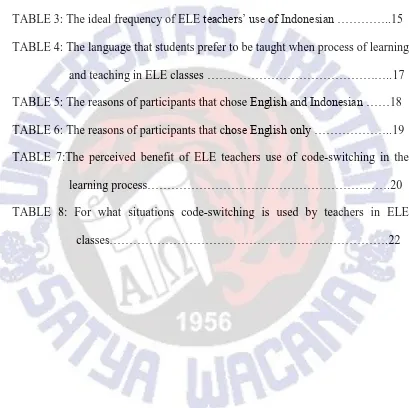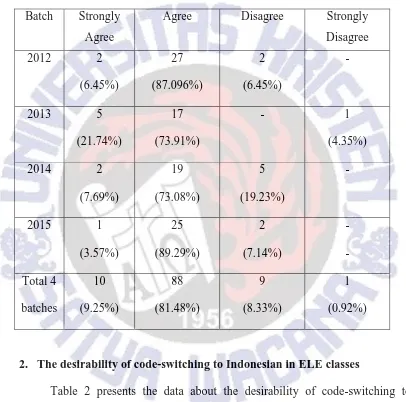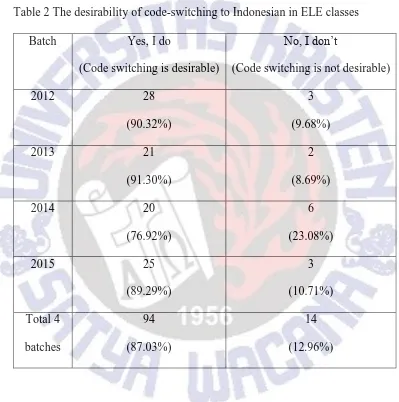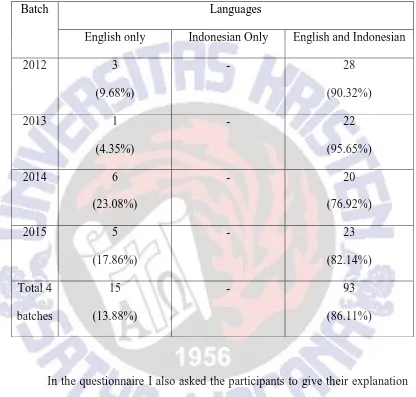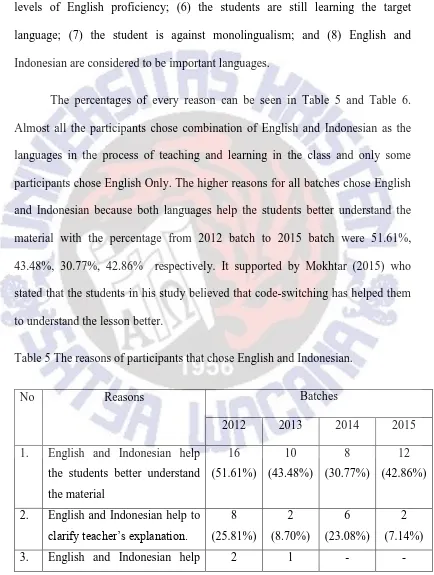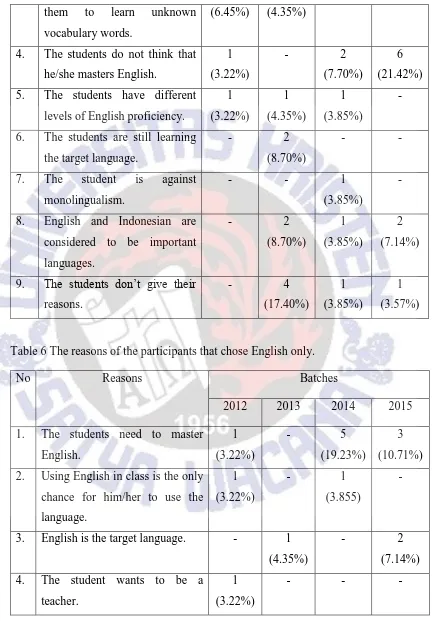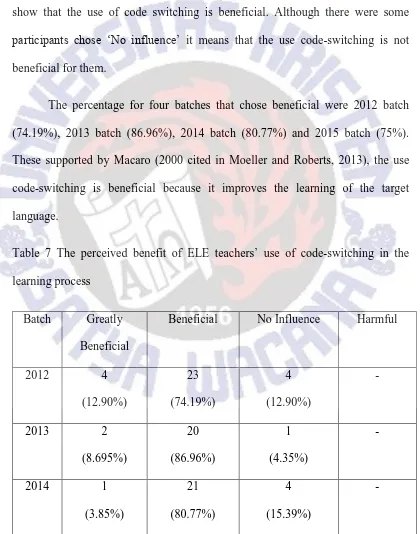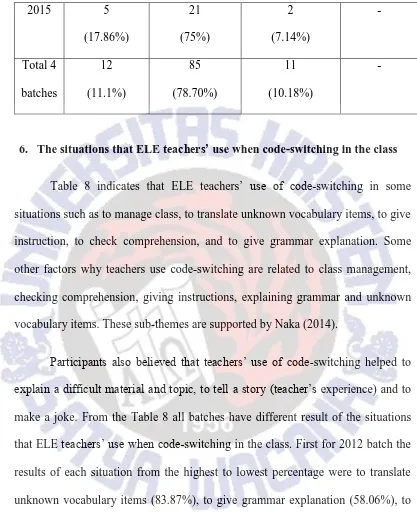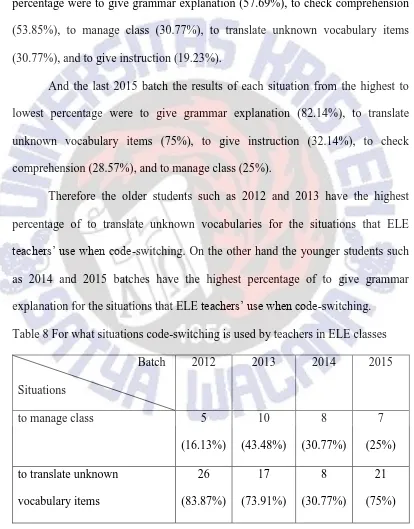ELE
STUDENTS’ ATTITUDES TOWARD TEACHERS’
USE
OF CODE-SWITCHING IN CLASS
THESIS
Submitted in Partial Fulfillment
of the Requirements for the Degree of
Sarjana Pendidikan
IVANA CHRISTINA HANDRIYO
NIM: 112012005
ENGLISH LANGUAGE EDUCATION PROGRAM
FACULTY OF LANGUAGE AND ARTS
UNIVERSITAS KRISTEN SATYA WACANA
i
ELE
STUDENTS’ ATTITUDES TOWARD TEACHERS’
USE
OF CODE-SWITCHING IN CLASS
THESIS
Submitted in Partial Fulfillment
of the Requirements for the Degree of
Sarjana Pendidikan
IVANA CHRISTINA HANDRIYO
NIM: 112012005
ENGLISH LANGUAGE EDUCATION PROGRAM
FACULTY OF LANGUAGE AND ARTS
UNIVERSITAS KRISTEN SATYA WACANA
iii
COPYRIGHT STATEMENT
This thesis contains no such material as has been submitted for examination in any course or accepted for the fulfillment of any degree or diploma in any university. To the best of my knowledge and belief, this contains no material previously published or written by any other person except where due references is made in the text.
Copyright @2016: Ivana Christina Handriyo and Joseph Ernest Mambu, Ph.D.
All rights reserved. No part of this thesis may be reproduced by any means without the prior written permission of at least one of the copyright owners or the English Language Education Program of Universitas Kristen Satya Wacana, Salatiga.
v
TABLE OF CONTENTS
COVER PAGE ………i
APPROVAL PAGE ………ii
COPYRIGHT STATEMENT ………iii
PUBLICATION AGREEMENT DECLARATION ………..iv
TABLE OF CONTENTS ………v
LIST OF TABLES ………....vii
ABSTRACT ………....1
INTRODUCTION ………..1
LITERATURE REVIEW ………4
Definition of Attitude ………4
Definition of Code-Switching ………...4
Review of Previous Studies ………...5
The reasons and functions of teachers in using code-switching in the class………..6
Peoples‟ attitudes toward the use code-switching in the ESL/ EFL Class……….7
THE STUDY ………..8
Research Methodology ………..8
vi
Participants………..9
Data Collection Instrument……….9
Data Collection Procedure ………10
Data Analysis Procedure ………...10
FINDINGS AND DISCUSSION ………...12
CONCLUSION ………24
ACKNOWLEDGEMENT ………...27
REFERENCES ………28
vii
LIST OF TABLES
TABLE 1: The students‟ degree of agreement with their teachers‟ use of code-switching in the ELE classes ……….13
TABLE 2: The desirability of code-switching to Indonesian in ELE classes …..14 TABLE 3: The ideal frequency of ELE teachers‟ use of Indonesian…………..15 TABLE 4: The language that students prefer to be taught when process of learning
and teaching in ELE classes ………..17 TABLE 5: The reasons of participants that chose English and Indonesian ……18
TABLE 6: The reasons of participants that chose English only ………..19 TABLE 7:The perceived benefit of ELE teachers use of code-switching in the
learning process……….20
TABLE 8: For what situations code-switching is used by teachers in ELE
1
ELE STUDENTS’ ATTITUDES TOWARD TEACHERS’ USE OF
CODE-SWITCHING IN CLASS students‟ attitudes toward teachers‟ use of code-switching in ELE classes. In this research quota sampling was used. The participants of this research were 108 students (25%) of English Language Education Program at Universitas Kristen Satya Wacana, Salatiga, Indonesia. I took the participants from four batches (i.e., the year when students were admitted in the program). The four batches were 2012, 2013, 2014, and 2015. The data were collected using a questionnaire with contains closed-ended questions and open-ended questions. The results of this research consist of six themes. First was the degree of students‟ agreement with teachers‟ use of code-switching in the ELE classes; second was the desirability of code-switching to Indonesian in ELE classes; third was the ideal frequency of ELE teachers‟ use of Indonesian; fourth was the language that students prefer to be taught during the process of learning and teaching in ELE classes; fifth was the perceived benefit of ELE teachers use of code-switching in the learning process; and sixth was the situations that ELE teachers‟ use when code-switching in the class. The result of this research showed that code-switching is beneficial and almost the students gave good attitudes toward the teachers‟ use of code-switching in class. Therefore teachers in ESL/ EFL class especially for teachers in ELE can be able to use code-switching as a tool for teaching in the class.
Keywords: code-switching, attitude, ELE students, ELE teacher.
INTRODUCTION
In ESL class (English as Second Language) and EFL class (English as Foreign Language) students study English as the target language, a language
2
main language that the teachers and students should use in class as the tool for communicating. In fact not all the students comprehend and master the target
language or English well. Therefore generally in ESL / EFL class teachers‟ use of code-switching to teach the students in the class. Code-switching is the way
people use other languages within a single sentences or utterance. According to Myers-Scotton (1997, as cited in Silberstein, 2008), code-switching is “when bilingual speakers switch from one language to another in the same discourse, sometimes within the same utterance” (p. 103).
In here code-switching is very beneficial because code-switching can help
the teacher easily to explain the difficult material that can not be explained with the target language (English language). Coste (1997, as cited in Moeller & Roberts, 2013) suggests that code-switching can be a fruitful teaching strategy
when it is used deliberately to further the students‟ Target Language proficiency by applying mother tongue or L1 as a reference point and to help to build up
knowledge in the Target Language. Cook (2001, cited in Jingxia, 2010) said that teachers must use the mother tongue or the L1 when „“the cost of the TL is too great” (p.418). Mokhtar (2015) stated that in his study, teachers gave positive
attitudes toward code-switching and the students believed that code-switching has helped them to understand the lesson better. Therefore teachers can use L1 or students‟ mother tongue when the students do not understand and need a long
time to comprehend the material that is delivered by the target language.
code-3
switching is not good or not beneficial. In here the use of the target language is better because students will be able to be expert the target language. Wong
Fillmore (1985, cited in Jingxia 2010) said that students who are used to listen their teacher uses the mother tongue of the students tend to neglect the target
language and therefore the students do not benefit fully from valuable target language input.
Based on the above debate over whether code-switching or L1 use in class
is beneficial, I am interested to do a research about ELE students‟ attitudes toward teachers‟ use of code-switching in ELE. In ELE I am studying English as the
target language. English is very important language and the main goal in ELE. Commonly teachers should use English all the time when teaching in the class because English as the target language, but in reality sometimes in ELE almost all
the teachers‟ use of code-switching as a tool to teach the students in the class. My question is “What are the students‟ attitudes toward their teachers‟ use of
code-switching in the class?” Therefore this study aims to know more deeply from ELE
students about their attitudes toward their teachers‟ use of code-switching while teaching in the class.
The significances of the study are: first, this study will give information to the ELE teachers about the ELE students‟ attitudes toward the teachers‟ use of
code-switching in the class. Second, not just for ELE teachers, but this study also to give information for ESL or EFL teachers and it may motivate teachers to reflect on their ways of using language ( whether using First Language, Target
4
LITERATURE REVIEW
Definition of attitude
Students‟ attitudes influence and have an important contribution in the
process of learning in the class. Attitude is a feeling, perspective or point of view
of people toward something. Ma (2014) argues that “basically, attitude refers to people‟s feeling or opinion about things or human beings” (p. 178).
Definition of code-switching
Code-switching is the way people use the other language in a single conversation. Commonly people that can speak more than one language do
switching when talking. Macaro (2014, as cited in Mokhtar, 2015) said that code-switching is one of the general communication abilities between bilinguals and is known to be a naturalistic occurrence outside the classroom environment.
According to Sridhar (2010), code switching is “when two or more languages exist in a community, speakers frequently switch from one language to another”
(p. 56). Another definition from Modupeola (2013) said that Code-switching is “regarded as a communicative phenomenon of constantly switching between two
languages in a bilingual‟s speech repertoire” (p. 92). Therefore, code-switching is
5
Review of Previous Studies
There are some students and teachers of ELE who have conducted their
studies about code-switching. First, in a study conducted by Hendrawan (2006), his research showed that there were six occasions where the teacher used
code-switching and code-mixing in the classroom, such as giving instruction and classroom management, giving explanation and justification, communicating meaning, giving direction, giving information, and repeating student‟s response
verbatim. Another study about code-switching was conducted by Ratnasari (2014). The results of her study include the reasons students‟ use of
code-switching in storytelling, such as lack of vocabulary knowledge, speaking anxiety, for facilitating of language production, to control the language, and absence of equivalence in the target language. Widiningrum and Kendenan (2013) have done
a research about the use of L1 in the Classroom interactions among the participants (between teacher and students) in poetry class. The result of this study
showed that teacher uses L1 to show empathy or solidarity.
Not just from my faculty, the other researchers from other institutions have conducted studies on code-switching. Alenezi (2010) suggests that students
provide positive attitudes and strong preference toward code switching. They believe that code-switching make the course easier to understand, although there
are some students strongly agree using one language (English only) is beneficial. In another study, Jingxia (2010) conducted his research in three Chinese universities and he focused on revealing the attitudes of teachers and students
6
in the EFL classroom. The result of his research suggests that code-switching to L1 is prevalent and it plays a positive role in the process of learning in the EFL
classroom. Moreover, Mokhtar (2015) stated that in his study, teachers gave positive attitudes toward switching and the students believed that
code-switching has helped them to understand the lesson better.
Compared to those studies that the topic is code-switching, a study about the ELE students‟ attitudes toward the teachers‟ use of code-switching in the class
at Universitas Kristen Satya Wacana is still necessary. For that reason this study is conducted to examine the ELE students‟ attitudes about their teachers‟ use of
code-switching while teaching in the class.
Theoretical framework
The reasons and functions of teachers in using code-switching in the class
In the ESL/EFL class it is very common for teachers to apply code-switching to teach their students, because code-code-switching has some functions.
Turnbull and Arnett (2002, as cited in Makulloluwa, 2013) identify three macro-functional categories of code-switching in the ESL classroom. The first function teachers‟ use the learners‟ L1 because for pedagogical purposes. The second is to
maintain social interaction, and the third is to organize the classroom. Next, according to Baker (2006, as cited in Alenezi 2010), code-switching can function
to emphasize a particular point, switch a word in place of unknown word in the target language, express a concept that has no equivalent in the culture of the other
7
friendship, to ease tension and inject humor into a conversation, and code-switching occurs when certain topics are introduced. Some other factors why
teachers use code-switching are related to class management, checking comprehension, giving instructions, explaining grammar and unknown vocabulary
items (Naka, 2014).
Peoples’ attitudes toward the use code-switching in the ESL/ EFL Class
Jingxia (2010) said that “code-switching in foreign language classroom has recently been the subject of considerable debate” (p.11). There are some
different attitudes toward the use of code-switching in class. The first attitude is
good or positive response to code-switching. I know that in the EFL/ ESL class students learn about another language not their L1. In this case the use of code-switching is beneficial for them to learn the target language. According to Swain
& Lapkin (2000, as cited in Moeller & Roberts, 2013), “using L1 to mediate TL learning can create a more affective learning environment” (p.23). In addition,
Macaro (2000 as cited in Moeller & Roberts, 2013) stated that the use of code-switching is beneficial when it improves the learning of the target language.
But in other side there are also people who do not fully agree with the use
of code-switching in the process of learning in class. These are the negative responses toward the use of code-switching in class because code-switching will
give a bad effect for the students who want to study the target language, if the teachers‟ always use L1 in the class will make the students do not get input and achieve the target language. Ellis (1984, cited in Jingxia 2010) stated that the use
8
valuable target language input. Next, Ma (2014) said that “For many decades, bilingual teaching has been dominated by the principle that teachers should use
only the target language and avoid using the mother tongue” (p.177). It is also supported by Widiningrum and Kendenan (2013) who said that teachers in a
Second and Foreign language courses mostly believed and also state a policy that it was a must for the teachers not only for students to use the target language. Therefore in this case teachers should use the target language in teaching and
learning process and teachers can not apply the L1 or mother tongue in the class.
THE STUDY
The research question of the current study is “What are the ELEstudents‟ attitudes toward their teachers‟ use of code-switching in the class?” The current research is a descriptive study. It will examine the ELE students‟ attitudes toward
their teacher use of code-switching.
Context
This research is conducted in the English Language Education Program (ELEP) of the Faculty of Language and Arts at Universitas Kristen Satya Wacana,
Salatiga, Central Java, Indonesia. I choose this faculty because in ELE use English as the medium instruction and the target language. Besides that, I am a student from ELE and I am still studying in this faculty, Therefore it is easier for me to
9
Participants
The participants of this research were 108 students in English Language
Education Program of Faculty of Language and Arts from four batches (i.e., the year when students were admitted in the program). The four batches were 2012
batch, 2013 batch, 2014 batch, and 2015 batch. To do this research I used quota sampling because I wanted to make sure all the batches in English Language Education Program of Faculty of Language and Arts were represented in my
research. Therefore I knew the result of every batch about their attitudes toward teachers‟ use of code-switching in class. In every batch I took 25% from the total
of the students from four batches were 431 students. The first for 2012 batch was 31 students of 125 students; the second for 2013 batch was 23 students of 92 students; the third for 2014 batch was 26 students of 102 students; and the fourth
for 2015 batch was 28 students of 112 students. I chose from four batches because they were from ELE and have been studying and taking some classes in ELE at
least 3.5 months or 1 semester for 2015 batch, one year for 2014 batch, two years for 2013 batch, and three years for 2012 batch.
Data Collection Instrument
The data were collected using a questionnaire with contains closed-ended questions and open-ended questions. There were 6 questions for Closed-ended
questionnaire of an adapted questionnaire was developed for this study with the title is Teachers‟ Code-Switching to the L1 in EFL Classroom by Liu Jingxia
10
used open-ended questionnaire because the participants were free to give and write their answer and I could get the deeper information from using open-ended
questionnaire.
Data Collection Procedure
The first step of collecting the data was to pilot the questionnaire. I distributed 10 questionnaires for doing the piloting. The function I did piloting
was to make sure that my questionnaire was good and could be understood by the participants. After that I distributed the 108 questionnaires to my participants in class and outside class. I also introduced myself and explained my questionnaire
before I asked them to fill my questionnaire. I finished distributing the 108 questionnaires about 12 days. It was started on March 7, 2016 and finished on
March 18, 2016.
Data Analysis Procedures
The first I was analyzing the data and counting the percentage of every
question and grouping it in every batch. After that I analyzed the result from the percentage of every batch. Then in open-ended question, I also grouped the students‟ answer based on the same reason. After that I made tables to make easier
to see the result. The next step was I made the theme based on the questions. The themes were the degree of students‟ agreement with teachers‟ use of code
11
perceived benefit of ELE teachers‟ use of code-switching in the learning process, and the situations that ELE teachers‟ use when code-switching in the class. The
12
FINDINGS AND DISCUSSIONS
108 questionnaires about students‟ attitudes toward their teachers‟ use of
code-switching in ELE classes have done to be filled by 108 participants. There are six themes will be discussed in this section. The six themes are the degree of students‟ agreement with teachers‟ use of code-switching, the desirability of
code-switching to Indonesian in ELE classes, the ideal frequency of ELE teachers‟ use of Indonesian, the language that students prefer to be taught when process of
learning and teaching in ELE classes, the perceived benefit of ELE teachers‟ use of code-switching in the learning process, and the last theme is the situations that ELE teachers‟ use when code-switching in the class.
1. The degree of students’ agreement with teachers’ use of code-switching
This section will discuss the degree of students‟ agreement with teachers‟
use of code switching. Every batch has different result of percentage about the agreement with teacher‟s use of code-switching. But overall all batches or most
participants agreed with their teachers‟ use of code-switching in the ELE classes. The result shows that 2012 batch who agreed was 87.096%, 2013 batch was 73.91 %, 2014 batch was 73.08% and 2015 batch was 89.29% (see Table 1). It means
that code-switching is usually accepted by ELE students and most of them agreed with their teachers‟ use of code-switching although there were some participants
who chose to disagree and strongly disagree with code-switching. It is supported by the research of Alenezi (2010). The result of the current study showed that students gave positive attitudes and strong preference toward code switching.
13
there are some students strongly agree that using one language (i.e., English only) is beneficial.
2. The desirability of code-switching to Indonesian in ELE classes
Table 2 presents the data about the desirability of code-switching to Indonesian in ELE classes. In here the desirability of code-switching means that
whether the use of code-switching in class is desirable or not. It can be seen in Table 2 that most the participants from four batches agreed with chose „Yes, I do‟. The percentage for every batch was 90.32% (2012 batch), 91.30% (2013 batch),
14
code-switching is desirable in the process of studying and learning in the ELE classes. According to Swain & Lapkin (2000, as cited in Moeller and Roberts,
2013), “using L1 to mediate TL learning can create a more affective learning environment” (p.23).
Table 2 The desirability of code-switching to Indonesian in ELE classes
Batch Yes, I do
3. The ideal frequency of ELE teachers’ use of Indonesian
This third theme is concerned with the ideal frequency of ELE teachers‟ use of Indonesian as L1. Table 3 shows that every batch has different attitudes toward the ideal frequency of ELE teachers‟ use of Indonesian. The first side from
15
“sometimes” for the ideal frequency of ELE teachers‟ use of Indonesian. The
results of both batches that chose “sometimes” were 54.84% and 69.57% for 2012
batch and 2013 batch respectively. But it is a little bit different for younger 2014 batch most participants chose “rarely” for the ideal frequency of ELE teachers‟
use of Indonesian with the percentage being 57.69% and most participants from batch 2015 also choose “rarely” with the percentage being 57.14%.
It means that the older the students, the more they accepted the use of
code switching in the class rather than the younger students, for example 2012 and 2013 batches preferred their teachers‟ use of L1 or Indonesian sometimes (54.84%
and 69.57% for batches 2012 and 2013 respectively, compared to 34.62% and 35.71% for batches 2014 and 2015 respectively). On the other hand, the younger students (2014 and 2015 batches) preferred their teachers‟ use of English
frequently in class rather than Indonesian but they still want their teacher use Indonesian while teaching in the class. Therefore code-switching can be accepted
for all batches from older batches until younger batches but with different frequency.
Table 3 The ideal frequency of ELE teachers‟ use of Indonesian
Batch Always Sometimes Rarely Never
16 learning and teaching in ELE classes
From the total of 108 participants (86.11%) wanted their teachers to use combination of English and Indonesian in the teaching and learning process in ELE classes. It is shown from the English and Indonesian column in Table 4. The
percentage of those who liked combined English and Indonesian from 2012 batch to 2015 batch were 90.32%, 95.65%, 76.92%, and 82.14% respectively. On the
other hand, those who preferred English only are the minority in the current study (look the column of “English only” in Table 4). Consistent with the previous
theme, however there are more students in the younger batches (2014 and 2015) who expected teachers to use English only (23.08% and 17.86% respectively). These percentages seem to be a lot higher than the older batches (9.68% and
17
Table 4 The language that students‟ prefer to be taught when process of learning
and teaching in ELE classes
Batch Languages
English only Indonesian Only English and Indonesian
2012 3 - 28
In the questionnaire I also asked the participants to give their explanation “Why did they choose English only, Indonesian only, or English & Indonesian?”
From the question the participants gave many reasons. The reasons I have grouped it into the main reasons. These are some reasons of participants to choose combination of English and Indonesian as the languages in class: (1) both
18
English and Indonesian help them to learn unknown vocabulary words; (4) the students do not think that he/ she masters English; (5) the students have different
levels of English proficiency; (6) the students are still learning the target language; (7) the student is against monolingualism; and (8) English and
Indonesian are considered to be important languages.
The percentages of every reason can be seen in Table 5 and Table 6. Almost all the participants chose combination of English and Indonesian as the
languages in the process of teaching and learning in the class and only some participants chose English Only. The higher reasons for all batches chose English
and Indonesian because both languages help the students better understand the material with the percentage from 2012 batch to 2015 batch were 51.61%, 43.48%, 30.77%, 42.86% respectively. It supported by Mokhtar (2015) who
stated that the students in his study believed that code-switching has helped them to understand the lesson better.
Table 5 The reasons of participants that chose English and Indonesian.
No Reasons Batches
2012 2013 2014 2015
1. English and Indonesian help the students better understand the material
19
Table 6 The reasons of the participants that chose English only.
20
5. The perceived benefit of ELE teachers’ use of code-switching in the learning process
The result of whether code-switching is beneficial or not in ELE classes it can be seen in Table 7. Overall the majority of participants from four batches
Beneficial No Influence Harmful
21
6. The situations that ELE teachers’ use when code-switching in the class
Table 8 indicates that ELE teachers‟ use of code-switching in some situations such as to manage class, to translate unknown vocabulary items, to give
instruction, to check comprehension, and to give grammar explanation. Some other factors why teachers use code-switching are related to class management, checking comprehension, giving instructions, explaining grammar and unknown
vocabulary items. These sub-themes are supported by Naka (2014).
Participants also believed that teachers‟ use of code-switching helped to
explain a difficult material and topic, to tell a story (teacher‟s experience) and to
make a joke. From the Table 8 all batches have different result of the situations that ELE teachers‟ use when code-switching in the class. First for 2012 batch the
results of each situation from the highest to lowest percentage were to translate unknown vocabulary items (83.87%), to give grammar explanation (58.06%), to
give instruction (45.16%), to check comprehension (25.80%), and to manage class (16.13%).
For 2013 batch the results of each situation from the highest to lowest
22
grammar explanation (65.22%), to give instruction (39.13%), to manage class (43.48%), and to check comprehension (26.09%).
For 2014 batch the results of each situation from the highest to lowest percentage were to give grammar explanation (57.69%), to check comprehension
(53.85%), to manage class (30.77%), to translate unknown vocabulary items (30.77%), and to give instruction (19.23%).
And the last 2015 batch the results of each situation from the highest to
lowest percentage were to give grammar explanation (82.14%), to translate unknown vocabulary items (75%), to give instruction (32.14%), to check
comprehension (28.57%), and to manage class (25%).
Therefore the older students such as 2012 and 2013 have the highest percentage of to translate unknown vocabularies for the situations that ELE teachers‟ use when code-switching. On the other hand the younger students such
as 2014 and 2015 batches have the highest percentage of to give grammar
explanation for the situations that ELE teachers‟ use when code-switching. Table 8 For what situations code-switching is used by teachers in ELE classes
23
to give instruction 14
(45.16%)
9 (39.13%)
5 (19.23%)
9 (32.14%)
to check comprehension 8 (25.81%)
6 (26.09%)
14 (53.85%)
8 (28.57%)
to give grammar explanation 18
(58.06%)
15
(65.22%)
15
(57.69%)
23
24
CONCLUSION
This research is conducted because it is necessary to know the students‟ attitudes toward their teachers‟ use of code-switching in the class because the students‟ attitudes can affect in the process of teaching and learning in the class.
This research was done in the English Language Education Program (ELEP) of the Faculty of Language and Arts at Universitas Kristen Satya Wacana, Salatiga, Central Java. The participants were from four batches. The four batches were
2012 batch, 2013 batch, 2014 batch, and 2015 batch. In order to know the students‟ attitudes toward their teachers‟ use of code-switching I have done to
distribute the 108 questionnaires and analyzed all the questionnaires.
The results of this research consist of six themes. The first theme was the degree of students‟ agreement with teachers‟ use of code-switching showed that
almost of the participants from all batches agreed with their teachers‟ use of code -switching with the total percentage from 4 batches were 81.48% that chose agree.
The second theme was the desirability of code-switching to Indonesian in ELE classes. In this second theme showed that code-switching is desirable for process teaching and learning in the class. The third was the ideal frequency of ELE teachers‟ use of Indonesian. The result showed that the ideal frequency for teachers‟ use of Indonesian was “sometimes”. The fourth was the language that
students prefer to be taught when process of learning and teaching in ELE classes. The languages that students preferred were combination between English and Indonesian because both languages help the students better understand the
code-25
switching in the learning process, the result of this research showed that the majority of the participants from four batches chose beneficial with the percentage
were 78.70%. The last theme was situations that ELE teachers‟ use when code -switching in the class. The result showed that there were two situations that teachers‟ use when code-switching. The situations were to translate unknown
vocabulary items and to give grammar explanation.
Over all the participants gave a positive responses and attitudes toward the
use of code-switching in the English Language Education Program of the Faculty of Language and Arts. Therefore ELE teachers can apply code-switching in the
process of teaching and learning because code-switching is not bad. On the other hand code-switching is alternative way to deliver material that can not be explained in English and to make the students better understand the materials. It is
supported by Swain & Lapkin (2000, cited in Moeller and Roberts, 2013), “using L1 to mediate TL learning can create a more affective learning environment”
(p.23).
For the last I hope this research will help the ELE teachers to reflect on their teaching, whether use code-switching or not. I do not suggest that all of the
ELE teachers use code-switching all the time when teaching in the class, but the use code-switching can be adjusted with the needs of the students. In the further
research, it might be fruitful to conduct to use other data collection methods such as observation and interview to get more data. In this study I only used questionnaire for getting the data. The other is the participant because of the
26
think if there is further research again about code-switching, it is better take the participants more than 50% or all of the ELE students can participate in this
27
ACKNOWLEDGEMENT
First of all I am very grateful and happy because I could finish my thesis. I
would give my biggest gratitude to my God, Jesus Christ because of his blessing and grace I could finish my thesis. To make this thesis I needed a long time and I
think this is not short journey to make and finish my thesis, but I am lucky I have a kind supervisor and examiner who have helped me to read, correct and give feedback to my thesis. Therefore I would like to say thank you very much to Dr.
Joseph Ernest Mambu as my supervisor and Rindang Widiningrum, M.Hum. as my examiner. Next I would like to thank you to my father, my mother, my
brothers and my sisters who have supported me to finish my thesis. I also thank to my participants who have helped me to fill my questionnaires. The last I would like to thank you to my friends who also gave me support when I made my thesis.
Over all I just want to say thank you because finally I could finish my thesis well.
28
REFERENCES
Alenezi, A. A. (2010). Students‟ language attitude towards using code-switching as a medium of instruction in the college of Health Sciences: an exploratory study. ARECLS,7, 1-22.
Hendrawan, Y. (2006). Code-switching and code-mixing used by the teacher of English at SMP Kristen 2 Salatiga (Undergraduate thesis). Universitas Kristen Satya Wacana, Salatiga Indonesia.
Jingxia, L. (2010). Teachers‟ code-switching to the L1 in EFL classroom. The Open Applied Linguistics Journal, 3, 10-23.
Ma, J. (2014). Students‟ attitudes towards code-switching in the bilingual classroom of Accounting English. Journal of Education and Practice, 5, 177-188.
Makulloluwa, E. (2013). Code switching by teachers in the second language classroom. International Journal of Arts & Sciences, 6(3), 581-598.
Modupeola, O. R. (2013). Code- switching as a teaching strategy: Implication for English language teaching and learning in a multilingual society. IOSR Journal of Humanities And Social Science, 14 (3), 92-94.
Moeller, A.J., & Roberts, A. (2013). Keeping it in the target language. Central
States Conference on the Teaching of Foreign Languages, 21-38.
Mokhtar, M.M. (2015). Lecturers‟ and students‟ beliefs in code-switching: A Malaysian polytechnic context. TEFLIN Journal, 26, 85-96. doi: http://dx.doi.org/10.15639/teflinjournal.v26i1
Naka, L. (2014, May 30-31). Advantages of mother tongue in English Language
29
and Education, Challenges Toward the Future, University of Shkodra,
Albania.
Ratnasary, E. (2014). The study of code-switching in storytelling (Undergraduate thesis), Universitas Kristen Satya Wacana, Salatiga, Indonesia.
Silberstein, S. (2008). Sociolinguistics. In R. Carter, & D. Nunan (Eds.), The Cambridge Guide to Teaching English to Speakers of Other Languages
(10th ed.) (p. 103). Cambridge: United Kingdom at the University Press.
Sridhar, K. K. (2010). Societal multilingualism. In S. L. McKay, & N. H. Hornberger (Eds.), Sociolinguistics and Language Teaching (14th ed.) (p. 56). United States of America: Cambridge University Press.
30
APPENDIX
Dear participants,
I am Ivana Christina Handriyo student of ELE who is doing research for my undergraduate thesis or “skripsi” under Dr. Joseph Ernest Mambu‟s supervision.
This questionnaire is designed to examine your attitudes toward the teachers‟ use
of code-switching in the ELE classes. Please spare a few minutes of your time to
fill out the questionnaire below honestly. This is not a test and there is no right or wrong answers. Thank you for your cooperation.
I. Demographic information
Gender : Male / Female Batch year (angkatan) :
Important note: Code-Switching means; using the other languages within a
single sentence or utterance (atau “ujaran”). For example; a teacher can change
from English to Indonesian while explaining a difficult material.
II. Please read each of the following statements very carefully and circle ( ) the answer!
1. How often do your teachers use Indonesian while teaching in the ELE classes?
a. Always b. Sometimes c. Rarely d. Never
2. What is your attitude toward your teachers‟ use of code-switching in the
ELE classes?
31
3. What is the ideal frequency of teachers use Indonesian in the ELE classes? a. Always b. Sometimes c. Rarely d. Never
4. Do you think code-switching to Indonesian is a desirable strategy in the process of learning in the ELE classes?
a. Yes, I do. b. No, I don‟t.
5. How does Code-switching to Indonesian influence the learning process in the ELE classes?
a. Greatly beneficial b. Beneficial c. No influence d. Harmful 6. In what situations do your teachers switch to Indonesian?
(You may give more than one choice.) a. to manage class
b. to translate unknown vocabulary items
c. to give instruction d. to check comprehension
e. to give grammar explanation
f. others, please specify ………..
………..
7. I would prefer the courses in ELE classes to be taught in (choose one answer):
a) English only. b) Indonesian only. c) English and Indonesian. Please explain your answer ………... ………
32
8. Is there any lecturer in ELE who never switches to Indonesian?
If yes, please mention who ………
III. Consent form
If I need more information on your answers, may I contact you for an
interview?
Yes / No (circle one). If you say “Yes”, please complete the following
information:
Name : Student number :
